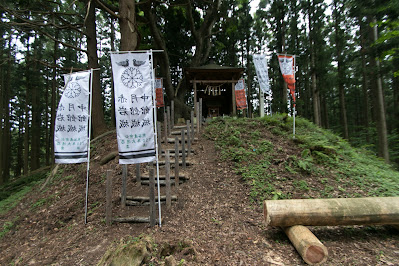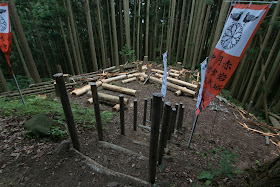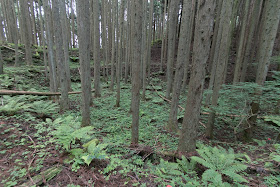Akaiwa Castle
-Castle of “East Guard”-
Overview
Name: Akaiwa castle (Akaiwa-jo)
Alias:
Place: Matsukawa Kesennuma city, Miyagi
Location: 38.91684280412226, 141.55007634006614
Type: Mountain Castle
Built: 14th century
Remaining remnants: Clay walls and moats
Title:
Akaiwa castle (赤岩城) is built over a hill which is the edge of the ridge continues from Nabekoshiyama mountain, the one at the northwest of Kesennuma city central. Kesennuma city is a port city that locates at the northeastern edge of current Miyagi prefecture, at the south edge of Sanriku ria coast which spreads over 200 kilometer along with Pacific Ocean.
Kesennuma port is a natural good port which is separated from outer sea by peninsula and islands. Now the size of the bay significantly decreased by land reclamation, but formerly it had a wide water inside narrow mouth and was appropriate for anchorage. In addition to this, Kesennuma bay has four rivers which flows into the bay, and each river is used as a communication route to inland area.
Especially Okawa river which flows from westward directly passes Kitakami mountains and continues to inland area such as Ichinoseki area or Oshu area without tight slope, thus even now used as a route of Ofunato line. Deep water and connection to inland area by railroad makes Kesennuma port as one of the major fishing ports of Japan, and Akaiwa castle stands at the entrance of Kesennuma area from inland area.
In 12th century, under Oshu Fujiwara clan once reigned the north half of Tohoku region, Kesennuma port was used as an outer port of the clan. Oshu Fujiwara clan had their main base at Hiraizumi area next to Kitagkami-gawa river, but current Ishinomaki port does not exist and marsh of wetlands prevented land transportation. There were gold mines such as Shishiori gold mine at the backside mountains, and Kesennuma port was used as lording port of such gold.
In 1189, Oshu Fujiwara clan was ruined by Yoritomo Minamoto (1147-1199), the founder of Kamakura Shogunate and already ruined Taira clan at the battle of Dannoura in 1185. Yoritomo gifted the former territory of Oshu Fujiwara clan to retainers who activated at the battle, and Kesennuma area was given to Kumagai clan.
Kumagai clan was originally a local lord of current Kumagaya city of Saitama prefecture. At the battle between Minamoto clan and Taira clan, Naozane Kumagai (1141-1207) killed Atsumori Taira (1169-1184), a young noble of Taira clan who was good at flute. Naozane fell the impermanence of the world from this fact the later became the monk under famous priest Honen (1133-1212).
His son Naoie Kumagai (1169-1221) also activated at the battle against Oshu Fujiwara clan and was praised as the bravest soldier of the army. Different from his father Naoie kept serving to Shogunate, and divided the territory of Kesennuma area to his son. Kumagai clan at Kesennuma area also spread into branch families resided various part around the bay.
Kumagai clan gradually grew their power, but at the west side of Kumagai clan, there was a strong lord Kasai clan which was nominated as a supervisor of Tohoku region by Kamakura Shogunate. Once the order of the region collapsed after the fall of Kamakura Shogunate, Kasai clan attacked Kumagai clan to expand their territory and seize Kesennuma port.
Kumagai clan gathered and resisted against Kasai clan, but defeated at the field battle then Kasai army siege Akaiwa castle which was built as a main base of Kumagai clan. Akaiwa castle resisted against the attack of Kasai clan but could not reverse the situation, thus Kumagai clan subordinated to Kasai clan in 1363.
Since then, Kumagai clan became a trusted retainer of Kasai clan. Kumagai clan followed the army of Kasai clan and activated at many battles, then gradually recovered their lost territories and called as “East Guard”. But the main base of Kumagai clan was still Akaiwa castle, and Akaiwa castle might be expanded along with the recovery of Kumagai clan.
Akaiwa castle is built at the place where the body of Nebekoshi-yama mountain directly faces Matsukawa river. Because of this condition, three direction of the castle is protected by sheer cliff of the river, and only northward is connected to backside mountains.
Central area of the castle is a terrace of about 50 meter long and 20 meter wide, now used as a ground of the shrine. From this central area, layers of terraces are built along the ridge continues southward, which are separated by sheer walls. Total size of the castle is about 400 meter long and 200 meter wide, and is suitable as a main base of Kumagai clan.
At the west of central area, ahead of small dry moat, secondary area of about 100 meter long and 50 meter width is located. This area might be used as a hilltop residence of the lord, as before land reclamation the castle directly faces the bay and there is no room for residence at hillside.
At the north of these two areas, a small valley opens westward between two ridges exists. As this valley is used as a climbing route, terraces two ridges and the top of the valley spreads like U letter and encircled this valley like a porch of the castle. At this area there was a marsh used as a water source of the castle.
In 16th century, too much separated Kumagai clan fell into internal conflicts by intervention of neighbor lords such as Ohara clan of Ohara castle (Iwate prefecture). This internal conflict continues over 50 years, but after the cease of this conflict Kumagai clan united again and worked hard under Kasai clan. At the rebel of Hamada clan, the lord of Rikuzen Takata area, Kumagai army broke Hamada army and its ally Shishiori clan worthy of its name.
However, in 1590, their master Kasai clan lost its territory because of the decision of central ruler Hideyoshi Toyotomi (1537-1598), blamed for no participation in his Odawara campaign against Hojo clan.
Next year former retainers of Kasai clan and Osaki clan rebelled against Toyotomi government but were suppressed, thus Kasai clan ended its history as a warlord. Kumagai clan also lost its territory, and descendants became retainer of neighbor feudal lords Date clan or Nanbu clan. Akaiwa castle was abolished at this time,
Now no building remains but structures of castle well remain over the hill. Secure terraces encircled climbing road to the castle well shows the tough history of Kumagai clan and effort to survive turbulent time. Now tunnel of road and railway area seen from castle site instead of sea in medieval era, but this shows Kesennuma area still the center of local communication and importance of Akaiwa castle to manage it.
20 minutes walk from JR East Ofunato line Kesennuma line Kesennuma station. 20 minutes drive from Sanriku Jidoshado Expressway Sanriku-Chuo interchange.
Type: Mountain Castle
Built: 14th century
Remaining remnants: Clay walls and moats
Title:
Brief History
Akaiwa castle (赤岩城) is built over a hill which is the edge of the ridge continues from Nabekoshiyama mountain, the one at the northwest of Kesennuma city central. Kesennuma city is a port city that locates at the northeastern edge of current Miyagi prefecture, at the south edge of Sanriku ria coast which spreads over 200 kilometer along with Pacific Ocean.
Kesennuma port is a natural good port which is separated from outer sea by peninsula and islands. Now the size of the bay significantly decreased by land reclamation, but formerly it had a wide water inside narrow mouth and was appropriate for anchorage. In addition to this, Kesennuma bay has four rivers which flows into the bay, and each river is used as a communication route to inland area.
Especially Okawa river which flows from westward directly passes Kitakami mountains and continues to inland area such as Ichinoseki area or Oshu area without tight slope, thus even now used as a route of Ofunato line. Deep water and connection to inland area by railroad makes Kesennuma port as one of the major fishing ports of Japan, and Akaiwa castle stands at the entrance of Kesennuma area from inland area.
After prosperity under Oshu Fujiwara clan
In 12th century, under Oshu Fujiwara clan once reigned the north half of Tohoku region, Kesennuma port was used as an outer port of the clan. Oshu Fujiwara clan had their main base at Hiraizumi area next to Kitagkami-gawa river, but current Ishinomaki port does not exist and marsh of wetlands prevented land transportation. There were gold mines such as Shishiori gold mine at the backside mountains, and Kesennuma port was used as lording port of such gold.
In 1189, Oshu Fujiwara clan was ruined by Yoritomo Minamoto (1147-1199), the founder of Kamakura Shogunate and already ruined Taira clan at the battle of Dannoura in 1185. Yoritomo gifted the former territory of Oshu Fujiwara clan to retainers who activated at the battle, and Kesennuma area was given to Kumagai clan.
Kumagai clan was originally a local lord of current Kumagaya city of Saitama prefecture. At the battle between Minamoto clan and Taira clan, Naozane Kumagai (1141-1207) killed Atsumori Taira (1169-1184), a young noble of Taira clan who was good at flute. Naozane fell the impermanence of the world from this fact the later became the monk under famous priest Honen (1133-1212).
"East Guard" of Kasai clan
His son Naoie Kumagai (1169-1221) also activated at the battle against Oshu Fujiwara clan and was praised as the bravest soldier of the army. Different from his father Naoie kept serving to Shogunate, and divided the territory of Kesennuma area to his son. Kumagai clan at Kesennuma area also spread into branch families resided various part around the bay.
Kumagai clan gradually grew their power, but at the west side of Kumagai clan, there was a strong lord Kasai clan which was nominated as a supervisor of Tohoku region by Kamakura Shogunate. Once the order of the region collapsed after the fall of Kamakura Shogunate, Kasai clan attacked Kumagai clan to expand their territory and seize Kesennuma port.
Kumagai clan gathered and resisted against Kasai clan, but defeated at the field battle then Kasai army siege Akaiwa castle which was built as a main base of Kumagai clan. Akaiwa castle resisted against the attack of Kasai clan but could not reverse the situation, thus Kumagai clan subordinated to Kasai clan in 1363.
Since then, Kumagai clan became a trusted retainer of Kasai clan. Kumagai clan followed the army of Kasai clan and activated at many battles, then gradually recovered their lost territories and called as “East Guard”. But the main base of Kumagai clan was still Akaiwa castle, and Akaiwa castle might be expanded along with the recovery of Kumagai clan.
Structure of Akaiwa castle
Akaiwa castle is built at the place where the body of Nebekoshi-yama mountain directly faces Matsukawa river. Because of this condition, three direction of the castle is protected by sheer cliff of the river, and only northward is connected to backside mountains.
Central area of the castle is a terrace of about 50 meter long and 20 meter wide, now used as a ground of the shrine. From this central area, layers of terraces are built along the ridge continues southward, which are separated by sheer walls. Total size of the castle is about 400 meter long and 200 meter wide, and is suitable as a main base of Kumagai clan.
At the west of central area, ahead of small dry moat, secondary area of about 100 meter long and 50 meter width is located. This area might be used as a hilltop residence of the lord, as before land reclamation the castle directly faces the bay and there is no room for residence at hillside.
At the north of these two areas, a small valley opens westward between two ridges exists. As this valley is used as a climbing route, terraces two ridges and the top of the valley spreads like U letter and encircled this valley like a porch of the castle. At this area there was a marsh used as a water source of the castle.
Sudden fall with master and afterward
In 16th century, too much separated Kumagai clan fell into internal conflicts by intervention of neighbor lords such as Ohara clan of Ohara castle (Iwate prefecture). This internal conflict continues over 50 years, but after the cease of this conflict Kumagai clan united again and worked hard under Kasai clan. At the rebel of Hamada clan, the lord of Rikuzen Takata area, Kumagai army broke Hamada army and its ally Shishiori clan worthy of its name.
However, in 1590, their master Kasai clan lost its territory because of the decision of central ruler Hideyoshi Toyotomi (1537-1598), blamed for no participation in his Odawara campaign against Hojo clan.
Next year former retainers of Kasai clan and Osaki clan rebelled against Toyotomi government but were suppressed, thus Kasai clan ended its history as a warlord. Kumagai clan also lost its territory, and descendants became retainer of neighbor feudal lords Date clan or Nanbu clan. Akaiwa castle was abolished at this time,
Now no building remains but structures of castle well remain over the hill. Secure terraces encircled climbing road to the castle well shows the tough history of Kumagai clan and effort to survive turbulent time. Now tunnel of road and railway area seen from castle site instead of sea in medieval era, but this shows Kesennuma area still the center of local communication and importance of Akaiwa castle to manage it.
Access
20 minutes walk from JR East Ofunato line Kesennuma line Kesennuma station. 20 minutes drive from Sanriku Jidoshado Expressway Sanriku-Chuo interchange.




































































































No comments:
Post a Comment